Showing 17–24 of 24 results
-
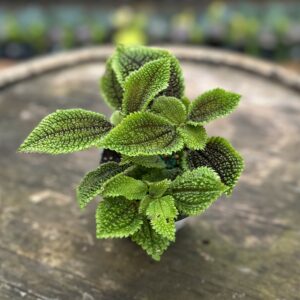

$12.99
Pilea ‘Moon Valley’
Light: Indirect to medium light; avoid direct sunlight.
Watering: Allow top inch of soil to dry between waterings; water moderately.
Humidity: Moderate to high humidity; mist occasionally.
Temperature: Maintain temperatures between 60-75°F (15-24°C).
Soil: Use well-draining, peat-based potting mix.
Fertilization: Feed monthly with a balanced liquid fertilizer during the growing season.
-
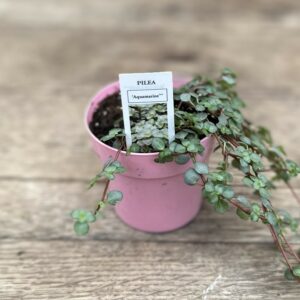
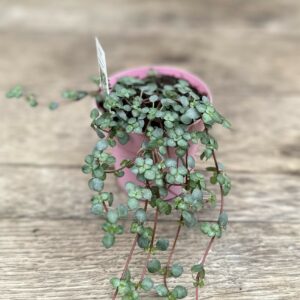
$9.99
Pilea glauca ‘Aquamarine’ Care
Light: Provide bright, indirect sunlight for your Pilea glauca ‘Aquamarine.’ It thrives in medium to bright indirect light.
Watering: Allow the top inch or so of the soil to dry out before watering.
Humidity: Pilea glauca ‘Aquamarine’ can tolerate average indoor humidity levels.
Temperature: Keep the plant in temperatures between 60-75°F (15-24°C).
Soil: Use a well-draining succulent or cactus potting mix.
Fertilization: Feed your Pilea glauca ‘Aquamarine’ with a diluted, balanced, water-soluble fertilizer during the growing season (spring and summer). Apply the fertilizer every 4-6 weeks to provide essential nutrients.
-


$7.99
Pothos ‘Golden’ Care
Light: Pothos ‘Golden’ thrives in medium to bright indirect light. It can tolerate lower light conditions, but its variegation will be more pronounced and vibrant in brighter light.
Watering: Allow the top inch or two of the soil to dry out before watering. Pothos prefers slightly moist soil but is quite forgiving if you occasionally let the soil dry out more.
Humidity: Pothos ‘Golden’ is adaptable to average indoor humidity levels.
Temperature: Keep the plant in temperatures between 60-85°F (15-29°C).
Soil: Use a well-draining potting mix. A mix designed for indoor plants or a mixture of potting soil, perlite, and orchid bark can work well.
Fertilization: Feed your Pothos ‘Golden’ with a balanced, diluted, water-soluble fertilizer every 4-6 weeks during the growing season (spring and summer).
-


$24.99
Pothos ‘N’Joy’ Care
Light: Provide bright, indirect light for your Pothos ‘N’joy.’ It thrives in medium to bright, indirect sunlight. It can tolerate low light conditions, but its variegation may become less pronounced. Avoid exposing it to direct sunlight, as this can scorch the leaves.
Temperature: Maintain a warm and consistent temperature. Pothos ‘N’joy’ prefers temperatures between 65°F to 80°F (18°C to 27°C). Protect it from cold drafts and sudden temperature fluctuations.
Pot and Soil: Plant your Pothos ‘N’joy’ in well-draining potting mix. A standard indoor plant mix with good drainage works well. Ensure the pot has drainage holes to prevent waterlogged soil.
Watering: Allow the soil to dry out slightly between waterings. Water sparingly but thoroughly, making sure the pot has drainage holes. Water when the top inch of soil feels dry. Pothos are relatively forgiving of underwatering but are sensitive to overwatering.
Humidity: Pothos ‘N’joy’ can tolerate average indoor humidity levels. However, they appreciate a bit of extra humidity. Misting the plant or using a humidity tray can help.
Fertilization: Feed your Pothos ‘N’joy’ sparingly. Use a balanced, water-soluble fertilizer diluted to half the recommended strength. Fertilize every 4-6 weeks during the growing season (spring and summer) and reduce or stop fertilization during the dormant period (fall and winter).
-

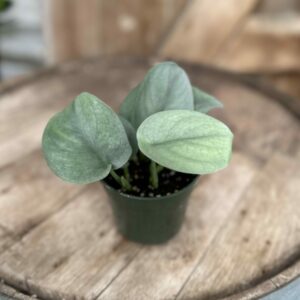
$29.99
Scindapsus pictus ‘Silver Hero’ Care
Light: Provide bright, indirect sunlight for your Scindapsus pictus ‘Silver Hero.’
Watering: Allow the top inch or so of the soil to dry out before watering.
Humidity: Scindapsus pictus ‘Silver Hero’ appreciates higher humidity levels.
Temperature: Keep the plant in temperatures between 60-85°F (15-29°C).
Soil: Use a well-draining potting mix. A mix designed for indoor plants or a combination of potting soil, perlite, and orchid bark can work well.
Fertilization: Feed your Scindapsus pictus ‘Silver Hero’ with a diluted, balanced, water-soluble fertilizer every 4-6 weeks during the growing season (spring and summer).
-
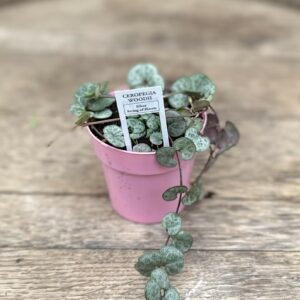
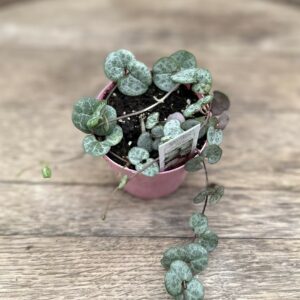
$9.99
String of Hearts ‘Silver’ Care
Light: Bright, indirect sunlight.
Watering: Allow the soil to dry out partially between waterings.
Soil: Use a well-draining succulent or cactus potting mix.
Temperature and Humidity: Prefers average room temperatures between 65°F to 80°F (18°C to 27°C).
Fertilizing: During the growing season, feed your String of Hearts with a balanced, diluted liquid fertilizer every 4-6 weeks.
-

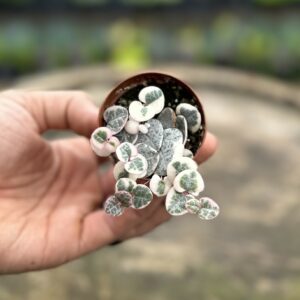
$5.99
String of Hearts (variegated) Care
Light: Bright, indirect sunlight.
Watering: Allow the soil to dry out partially between waterings.
Soil: Use a well-draining succulent or cactus potting mix.
Temperature and Humidity: Prefers average room temperatures between 65°F to 80°F (18°C to 27°C). Normal indoor humidity levels are typically sufficient.
Fertilizing: During the growing season, feed your String of Hearts with a balanced, diluted liquid fertilizer every 4-6 weeks.
-


$12.99
Venus Fly Trap Care
Light: Venus Fly Traps need bright, direct sunlight to thrive. They should receive at least 4-6 hours of direct sunlight each day. Place them in a south-facing window or under artificial grow lights. Inadequate light can weaken the plant.
Water: Use distilled or rainwater to water your Venus Fly Trap. Avoid tap water or bottled water with added minerals, as these can harm the plant. Keep the soil consistently moist but not waterlogged. Always keep the saucer underneath the pot filled with water to maintain the required humidity.
Humidity: Venus Fly Traps require high humidity levels. You can increase humidity by placing the pot on a tray filled with water, using a humidity tray, or misting the plant regularly. Avoid letting the soil dry out.
Soil: Plant your Venus Fly Trap in a mixture of sphagnum moss and perlite. This soil combination provides the necessary acidity and moisture retention the plant needs.
Feeding: Venus Fly Traps obtain essential nutrients from the insects they capture. While it’s not required to feed them, if your plant doesn’t catch enough insects naturally, you can provide small insects, such as live flies or ants, to stimulate growth. Do not feed it human food or inorganic materials.
Triggers: Avoid touching the sensitive trigger hairs inside the traps. Repeatedly triggering the traps without prey can exhaust the plant’s energy.
















